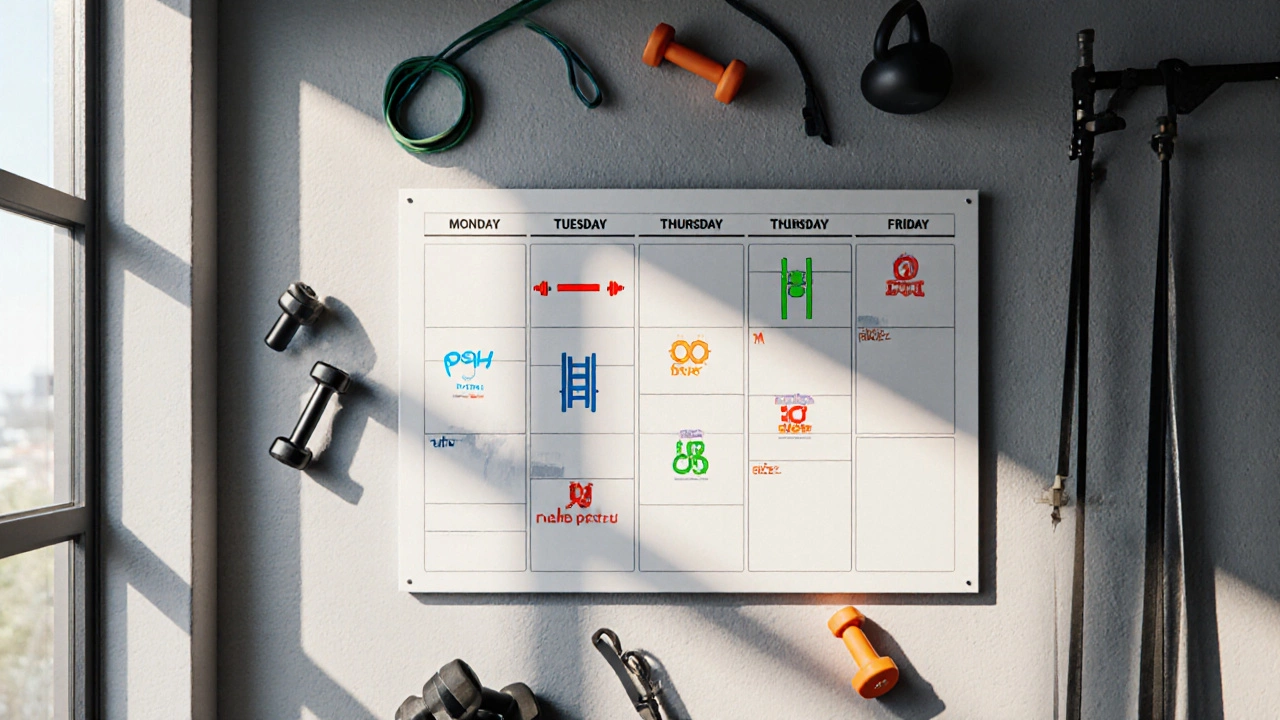Ideal 4-Day Workout Routine: Full-Body Split for Strength and Muscle
 Oct, 9 2025
Oct, 9 2025
4-Day Workout Routine Planner
Your Personalized 4-Day Plan
Track your workouts and gradually increase:
- Weight (add 2.5-5 lbs weekly when you can maintain form)
- Reps (aim for 1-2 extra reps before increasing weight)
- Volume (add one extra set to accessory exercises)
Review your progress every 4 weeks and adjust accordingly!
When you’re looking for a balanced plan that hits every major muscle group without burning you out, a 4-Day Split Workout Routine often fits the bill. It gives you enough frequency to drive growth while still leaving room for recovery, which is the sweet spot for most people aiming to get stronger and add size.
Key Takeaways
- Four training days lets you train each muscle group twice a week with enough rest.
- Pairing push, pull, and leg days creates a natural movement pattern flow.
- Stick to 3-4 compound lifts per session, supplement with 2-3 isolations.
- Progressive overload-adding weight, reps, or volume-drives results.
- Recovery (sleep, nutrition, rest days) matters as much as the lifts themselves.
Understanding the 4‑Day Split
The idea behind a split is simple: you separate muscle groups across different days so you can give each one the attention it deserves. A classic layout looks like this:
- Day1 - Push Day (chest, shoulders, triceps)
- Day2 - Pull Day (back, biceps, rear delts)
- Day3 - Rest or active recovery
- Day4 - Leg Day (quads, hamstrings, glutes, calves)
- Day5 - Upper Body (combined push/pull focusing on volume)
- Day6 - Rest or light activity
- Day7 - Full rest
This pattern gives each muscle group roughly 48‑72 hours between sessions, which aligns with research on protein synthesis and recovery. If you can’t fit six days into a week, simply shift the upper‑body day to the start of the next cycle and keep the rest days where they land.
Day‑by‑Day Breakdown
Below is a sample structure that works for beginners to intermediate lifters. Adjust load and volume based on your personal strength levels.
| Day | Focus | Primary Compound Lifts | Supportive Isolation Work |
|---|---|---|---|
| 1 - Push | Chest, Shoulders, Triceps | Barbell Bench Press, Overhead Press, Incline Dumbbell Press | Lateral Raises, Triceps Rope Push‑Down, Chest Flyes |
| 2 - Pull | Back, Biceps, Rear Delts | Deadlift, Pull‑Ups, Bar‑bell Row | Face Pulls, Bicep Curls, Rear‑Deltoid Flyes |
| 3 - Rest / Active | Recovery | - | Light cardio, mobility work |
| 4 - Legs | Quads, Hamstrings, Glutes, Calves | Squat, Romanian Deadlift, Leg Press | Leg Curls, Calf Raises, Hip Thrusts |
| 5 - Upper Body (Optional) | Balanced push/pull volume | Close‑Grip Bench, Seated Row, Arnold Press | Cable Flyes, Hammer Curls, Shrugs |
| 6 - Rest / Light | Recovery | - | Stretching, foam rolling |
| 7 - Full Rest | Complete recovery | - | - |
Each compound lift is a Compound Exercise that recruits multiple muscle groups and joints, while the isolations let you fine‑tune weaker points. Aim for 3-4 sets of 6-10 reps on the big lifts and 2-3 sets of 10-15 reps on the accessories.

Choosing Between Compound and Isolation Work
Why bother with isolations at all? Because they create a mind‑muscle connection and can fix imbalances that compound movements hide. For example, if your triceps lag behind your chest, adding a few sets of triceps rope extensions after bench pressing can bring that arm strength up to speed.
Think of Isolation Exercise as a precision tool. It’s not the main driver of growth, but it adds detail and helps you avoid plateaus.
Sets, Reps, and Progressive Overload
Growth won’t happen by repeating the same numbers forever. Progressive Overload is the principle of gradually increasing the stress placed on muscles. Here are three easy ways to apply it:
- Weight: Add 2.5-5lb to the bar each week if you can hit the target rep range with good form.
- Reps: If adding weight feels too jumpy, aim for an extra rep or two before moving up.
- Volume: Tuck in an additional set on the last accessory exercise.
Track these variables in a notebook or a simple app. Over a 12‑week block you should see noticeable strength gains, which translate to bigger muscles.
Recovery: Rest Days and Nutrition
Even the best‑designed split falls apart without adequate recovery. Your Rest Day is when muscles rebuild and hormonal balance resets should include quality sleep (7‑9hours), adequate protein (1.6‑2.2g per kg body weight), and moderate carbs to refill glycogen.
Hydration and micronutrients (magnesium, zinc, vitaminD) also play a big role in muscle repair. If you’re training hard, consider a post‑workout shake with 20‑30g protein and a fast‑acting carb source.

Customising for Your Goal: Strength vs Hypertrophy
If your main aim is maximal strength, keep reps low (3‑5) and focus on heavy compound lifts. For muscle size, raise the rep range to 8‑12 and add more isolation volume. You can even blend the two by rotating a “strength” week (low reps) with a “hypertrophy” week (higher reps) every four weeks.
Another tweak is to add a “power” day after your leg session where you perform box jumps or weighted sled pushes. This improves explosiveness without compromising overall volume.
Common Mistakes to Avoid
- Skipping the warm‑up. A 5‑minute dynamic routine saves joints and improves activation.
- Training to absolute failure on every set. One or two near‑failure sets per muscle group is enough; the rest should stay a couple of reps shy of the limit.
- Neglecting mobility. Tight hip flexors or shoulder caps can limit depth on squats and presses, leading to injury.
- Doing the same weight for months. If the bar isn’t moving, the muscle isn’t getting a new stimulus.
- Under‑estimating rest days. More rest does not mean less progress - it means smarter progress.
By fixing these errors early, your 4‑day plan stays sustainable and effective.
Putting It All Together
Start by picking the day order that matches your calendar - Monday Push, Tuesday Pull, Thursday Legs, Friday Upper Body works for many people. Fill each session with the compound lifts listed, add the accessory work, and record your sets, reps, and weight. Follow the progressive overload cues, respect rest days, and fuel your body with enough protein and sleep.
In a few weeks you’ll notice stronger lifts, tighter muscles, and more confidence in the gym. That’s the power of a well‑structured 4 day workout routine.
Frequently Asked Questions
Can I do a 4‑day split if I only have three days per week?
Yes. Combine push and pull into one upper‑body day, keep a dedicated leg day, and use the third day for full‑body conditioning. The key is still to hit each muscle group at least twice every two weeks.
How much weight should I start with for compound lifts?
Begin with a load that lets you complete 8‑10 reps with moderate difficulty. A good rule of thumb is ~50‑60% of your estimated 1‑rep max for the first week, then increase by 2.5‑5lb each session if you can maintain form.
Should I do cardio on rest days?
Light cardio (20‑30minutes of walking, cycling, or rowing) can boost blood flow and aid recovery. Keep intensity below 60% of your max heart rate to avoid taxing the nervous system.
Is it okay to change exercise order each week?
Occasionally swapping the order of accessories can prevent adaptation and keep workouts fresh. However, keep the primary compound lift first to ensure you’re fresh for the most demanding movement.
What’s the best way to track progress?
Use a simple spreadsheet or app. Log the exercise, weight, reps, sets, and any notes on difficulty. Review it every four weeks to see trends and plan deloads or new overload steps.
